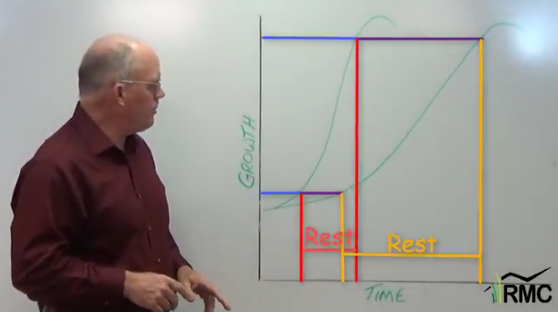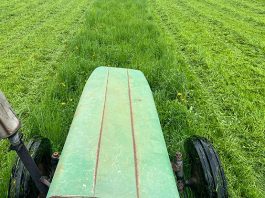

Thanks to Brad Schick, Nebraska Extension Educator and the University of Nebraska-Lincoln BEEFWatch newsletter for this great article!
 Having corn stalks to graze is a great resource for livestock producers. For dry cows, it is a relatively inexpensive feed that can typically meet, or come very close to meeting nutritional needs. Grazing can also be an inexpensive way to clean up a corn field too, geting rid of corn remaining in the field and reducing volunteer corn the following year.
Having corn stalks to graze is a great resource for livestock producers. For dry cows, it is a relatively inexpensive feed that can typically meet, or come very close to meeting nutritional needs. Grazing can also be an inexpensive way to clean up a corn field too, geting rid of corn remaining in the field and reducing volunteer corn the following year.
But are cattle really grazing stalks?
Yes and no. In everyday conversation, grazing corn stalks is what we call it, but the stalk is the last thing cattle eat. Cattle do eat stalks, particularly if they are left on a field too long, but they are primarily consuming leaf, husk, and leftover corn. The stem or stalk makes up about 48.5% of the residue, while the leaf blade and husk make up 39.6%. Cattle will consume leaf and husk if available. That diet will consist of 52 to 55% TDN (total digestible nutrients) and 5 to 5.5% crude protein.
How Much Feed Is Out There?

When thinking about how long to graze corn residue, the calculation to use is for every bushel of corn produced, there is 16 lbs of dry leaf and husk. The recommended grazing plan should be to remove 50% of the leaf and husk. This assumes that portions of the forage will also be lost to trampling, defecation, and other considerations such as wind. Now we have 8 lbs of good forage on a dry matter basis available for consumption for every bushel of corn.
For example, say the field produced 200 bu/ac corn. By our calculations, there is 1600 lbs of dry matter per acre available (8 lbs X 200 bu = 1600 lbs).
A 1000 lb animal will consume about 26 lbs of dried forage per day which means a 1300 lb animal will consume about 34 lbs per day. However, with lower quality forage such as corn residue, intake will be closer to 2% of bodyweight. In this example, that means closer to 26 lbs for the 1300 lb animal. So, how many days of grazing is that?
Using our formula we find that there are 61 days of grazing for one cow grazing one acre:
(1600 lbs DM ÷ 26 lbs = 61 days).
A general rule is about 30 cow days per 100 bushels of corn produced.
Adjust Grazing Management to Crop Field Conditions
In years when there is ear drop, plants blown over, or other factors, the calculations will likely need to be adjusted. That is when good observation is critical. Checking how much corn is on the ground can help with supplementation costs if needed and to make sure cattle are safe to graze corn residue. A way to calculate the amount of corn on the ground is found in the article Estimating Bushels of Corn on the Ground by Counting Ears Prior to Grazing with Cattle. A way to allocate grazing with excessive corn is seen below.
| Ears in 300 ft | Grain (bu/ac) | Grain (lb/ac) | Limit 10 (lbs/day) | Limit 15 (lbs/day) |
| 20 | 10 | 560 | 1.8 (Acres per 100 cows) | 2.7 (Acres per 100 cows) |
| 30 | 15 | 840 | 1.2 (Acres per 100 cows) | 1.8 (Acres per 100 cows) |
| 40 | 20 | 1120 | 0.9 (Acres per 100 cows) | 1.3 (Acres per 100 cows) |
| 50 | 25 | 1400 | 0.7 (Acres per 100 cows) | 1.1 (Acres per 100 cows) |
| 60 | 30 | 1680 | 0.6 (Acres per 100 cows) | 0.9 (Acres per 100 cows) |
| 70 | 35 | 1960 | 0.5 (Acres per 100 cows) | 0.8 (Acres per 100 cows) |
| 80 | 40 | 2240 | 0.4 (Acres per 100 cows) | 0.7 (Acres per 100 cows) |
| 90 | 45 | 2520 | 0.4 (Acres per 100 cows) | 0.6 (Acres per 100 cows) |
| 100 | 50 | 2800 | 0.4 (Acres per 100 cows) | 0.5 (Acres per 100 cows) |
What Animals Class of Animals Do Well on Corn Residue?
In addition to grazing cows on crop residue, calves and replacement heifers can be also be a great option. Just remember that they will need a protein source to meet their growing requirements.
It’s a Win-Win
Grazing corn residue, done right, can be very beneficial to the cow and the producer’s bottom line. Studies from the University of Nebraska-Lincoln have shown that grazing corn residue increases or at least maintains crop yields.




I grazed corn stalks/stover for first time last year, I wondered for most of first 2 weeks, giving new area each day, then all of lye sudden the cows figured it out. They visibly increased the amount of leaves and husks they were eating, more exciting was to see them searching row by row for dropped ears. They advanced across the field like across a fresh pasture as I moved the poly wire, and stayed out until late December when it was wet enough to bring them off. Like winter grazing a back wire was not needed.
What was old, is new. I cannot remember the agronomist who said that, but she was on point. Post harvest grazing was common around the world. It wipes out a lot of weeds, crushes insect pests weathering winter in stalks, and fertilizes fields. Follow with hogs and forget bindweed and other problems. Rye and clover, as well as other covers follow the hogs and you’re set to stop erosion and create a very soft soil for tilling, or more graze, or a heavy mulch if no-till.
Comments are closed.